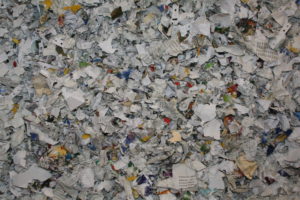Another year is nearly over. No matter what victories and challenges the year held for your business, one thing is certain: You accumulated a ton of stuff. How many sheets of paper were added to your files this year? How many devices broke down and had to be replaced? If your year was busy, there’s a good chance that a lot of non-emergency tasks, like collecting old documents and devices for shredding, got shuttled to the back burner. But taking pains to protect your sensitive data isn’t just a smart New Year’s resolution; it’s a necessity if you want to continue to grow your business and protect its future. Follow these end-of-year best practices to position yourself for that future before a busy new year gets underway.
Take a Formalized Approach
 The end of the calendar year tends to be hectic. You could send out an email asking your workforce to gather up anything that needs to be shredded before the end of the year, but such a request might slip through the cracks for busy workers. To make sure that all sensitive data is properly destroyed and nothing is overlooked, consider adopting a more organized strategy. That might mean making a clean-out schedule for the entire workplace, or appointing someone to be in charge of collecting items that need shredding from every department.
The end of the calendar year tends to be hectic. You could send out an email asking your workforce to gather up anything that needs to be shredded before the end of the year, but such a request might slip through the cracks for busy workers. To make sure that all sensitive data is properly destroyed and nothing is overlooked, consider adopting a more organized strategy. That might mean making a clean-out schedule for the entire workplace, or appointing someone to be in charge of collecting items that need shredding from every department.
Do a Deep Dive
Depending on the nature of your business, it might be impossible to look through every single sheet of paper in your offices every year. Of course, the same has probably been true for the last several years too, so there’s a good chance you’re hanging onto a lot of files you no longer need. During the year your employees might only toss documents in the to-be-shredded bin when they have a reason to handle those documents. Consider sorting through your all files to clear out everything that’s no longer necessary, just as you might go through your closet once a year to clean out things you no longer wear.
If your team doesn’t have the time or capacity to do a really thorough search through your files in December, consider delaying your clean-out until early January. The first few weeks of the new year might be quieter for your business, making this a good time to undertake such a project without affecting productivity.
Verify Retention Dates
The end of the year is also a good time to verify that you’re complying with any industry regulations, company requirements or state laws around document retention. Are you keeping documents related to compliance for the proper length of time? Do you know how long financial statements should be kept? If you’re one branch of a larger firm, are you following company guidelines for document retention? What does your accountant say about how long to hold onto financial documents? Obviously, complying with any applicable laws is important for liability reasons, but brushing up on current requirements also gives you the freedom to dispose of unnecessary documents without fear that you’ll suffer any consequences for having done so.
If you’ve created your own document retention policies in-house, the end of the year is a natural time to assess how they’re working. Were there times over this past year when necessary information was unavailable because documents had been shredded too early? On the other hand, were there times this year when you needed storage space that was taken up with old documents that no one touched or needed?
Look Beyond Documents
Obsolete paperwork tends to be the focus of end-of-the-year clean-outs, but documents aren’t the only things in your workplace that need to be shredded when they’re no longer being used. Things like old employee ID badges, hard drives, broken electronics and old thumb drives can all store sensitive data, so they all need to be shredded rather than landfilled. They’re the kinds of things that employees tend to stash in the backs of drawers or in storage closets and forget about. Because they’re considered obsolete, those items tend not to be protected with security measures the way functional devices and badges are.
If the wrong person found an old thumb drive that had recoverable financial information on it, would you ever even know the breach had happened? That’s not a risk you can afford to take. When you’re sorting through sensitive files at the end of the year, collect these devices too. You’ll free up storage space and eliminate potential security threats at the same time.
Assess Your Needs
Use the end of the year to evaluate how your shredding and recycling systems have been working. Were there any issues with your recycling bins always overflowing, or with how your employees dispose of sensitive files? Did your business grow, increasing your output of paper waste? Did you have any security breaches that you’re eager to avoid repeating this year? If there are any weaknesses in your systems around these issues, make adjustments now.
Northeast Data Destruction can help you protect your sensitive data this coming year. Let us provide secure, locked containers for your end-of-year clean-out. We’ll pick them up once you’re ready, and provide a Certificate of Destruction when the job is done. How can Northeast Data Destruction help you prepare for the year ahead? Contact us today!
